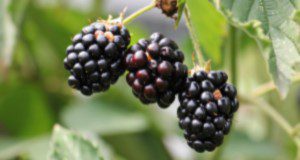Abstract
Blackberry (Rubus spp.) is a deciduous berry crop and the fourth most economically important berry crop in the United States. Driven by the growing demand for blackberries, production recently expanded to the southeastern United States. In Florida, however, commercial blackberry production is limited primarily to small commercial U-pick operations. The main challenges include insufficient chill hours and poor fruit quality associated with the subtropical climate. This new 6-page article, a publication of the UF/IFAS Horticultural Sciences Department, will discuss important cultivar selection criteria and recommended blackberry cultivars in subtropical Florida. Written by Shinsuke Agehara, Syuan-You Lin, and Zhanao Deng.
https://edis.ifas.ufl.edu/hs1352
References
Andersen, P. C. 2017. The Blackberry. HS807. Gainesville: University of Florida Institute of Food and Agricultural Sciences. http://edis.ifas.ufl.edu/hs104.
California Strawberry Commission. 2017. “Retail Category Trends – Total U.S.” 13 Oct. 2019. https://www.calstrawberry.com/Portals/2/Reports/Retail Reports/Retail Category Trends/Retail Category Trends - Total U.S. - 12.03.17.pdf.
Clark, J. R. 2014. "'Prime-Ark® Freedom' Primocane-Fruiting Thornless Blackberry." HortScience 49: 1097-1101. https://doi.org/10.21273/HORTSCI.49.8.1097
Clark, J. R. 2013. "'Osage' Thornless Blackberry." HortScience 48: 909-912. https://doi.org/10.21273/HORTSCI.48.7.909
Clark, J. R. 2005. "Changing Times for Eastern United States Blackberries." HortTechnology 15: 491-494. https://doi.org/10.21273/HORTTECH.15.3.0491
Clark, J. R., and J. N. Moore. 2008. "'Natchez' Thornless Blackberry." HortScience 43: 1897-1899. https://doi.org/10.21273/HORTSCI.43.6.1897
Clark, J. R., and J. N. Moore. 2005. "'Ouachita' Thornless Blackberry." HortScience 40: 258-260. https://doi.org/10.21273/HORTSCI.40.1.258
Clark, J. R., and C. E. Finn. 2011. “Blackberry Breeding and Genetics.” Fruit, Veg. Cereal Sci. Biotechnol. 5: 27–43.
Clark, J. R., and P. Perkins-Veazie. 2011. "'APF-45' Primocane-Fruiting Blackberry." HortScience 46: 670-673. https://doi.org/10.21273/HORTSCI.46.4.670
Clark, J. R., and A. Salgado. 2016. "'Prime-Ark® Traveler' Primocane-Fruiting Thornless Blackberry for the Commercial Shipping Market." HortScience 51: 1287-1293. https://doi.org/10.21273/HORTSCI10753-16
Clark, J. R., M. Worthington, and T. Ernst. 2019. "'Caddo' Thornless Blackberry." HortScience 54: 1632-1636. https://doi.org/10.21273/HORTSCI14119-19
Finn, C. E., and J. R. Clark. 2017. "Cultivar Development and Selection." In Blackberries and Their Hybrids, edited by H. K. Hall and R. C. Funt. 63-92. Boston: CABI. https://doi.org/10.1079/9781780646688.0063
Hummer, K. E. 2017. "Blackberries: An Introduction" In Blackberries and Their Hybrids, edited by H. K. Hall and R. C. Funt. 1-16. Boston: CABI. https://doi.org/10.1079/9781780646688.0001
Lee, J., M. Dossett, and C. E. Finn. 2012. "Rubus Fruit Phenolic Research: The Good, the Bad, and the Confusing." Food Chem. 130: 785-796. https://doi.org/10.1016/j.foodchem.2011.08.022
Lin, S.-Y., and S. Agehara. 2017. “Foliar Spray of Gibberellic Acid Improves the Onset of Bud Break and Fruit Set of Blackberries in Florida.” Proc. Fla. State Hort. Soc. 130: 11–13.
Lin, S.-Y., and S. Agehara. 2018. “Phenology, Yield and Fruit Quality of Floricane-Fruiting Blackberry Cultivars under High Tunnel and Net House Production Systems in Florida.” Proc. Fla. State Hort. Soc. 131: 13–16.
McWhirt, A. 2016. “Blackberry Variety Selection.” 29 Jan. 2018. http://extension.missouri.edu/greene/documents/Horticulture/Blackberry/Blackberry Cultivars%2C McWhirt Nov_15%2C2016.pdf.
Moore, J. N., and J. R. Clark. 1989. “‘Navajo’ Erect Thornless Blackberry.” HortScience 24: 863–865.
Smith, B. J. 2017. “Rosette of Blackberry.” In Compendium of Raspberry and Blackberry Diseases and Pests (2nd ed.), edited by R. R. Martin, M. A. Ellis, B. Williamson, and R. N. Williams. 23–25. St. Paul: The American Phytopathological Society.
Stanton, M. A., J. C. Scheerens, R. C. Funt, and J. R Clark. 2007. "Floral Competence of Primocane-Fruiting Blackberries Prime-Jan and Prime-Jim Grown at Three Temperature Regimens." HortScience 42: 508-513. https://doi.org/10.21273/HORTSCI.42.3.508
Strik, B. C. 2017. "Growth and Development." In Blackberries and Their Hybrids, edited by H. K. Hall and R.C. Funt. 17-34. Boston: CABI. https://doi.org/10.1079/9781780646688.0017
Strik, B. C., J. R. Clark, C. E. Finn, and M. P. Ban. 2007. "Comprehensive Crop Reports Worldwide Blackberry Production." HortTechnology 17: 205-213. https://doi.org/10.21273/HORTTECH.17.2.205
U.S. Department of Agriculture. 2017a. “USDA/NASS Quickstats Ad-Hoc Query Tool.” 8 July 2019. https://quickstats.nass.usda.gov/results/DD972F9C-AE69-3298-B2DB-1257DC6A95CF.
U.S. Department of Agriculture. 2017b. “USDA/NASS Quickstats Ad-Hoc Query Tool.” 8 July 2019. https://quickstats.nass.usda.gov/results/08D195DC-7B67-32E7-9167-4314A69E6E69.
U.S. Department of Agriculture. 2017c. “USDA/NASS Quickstats Ad-Hoc Query Tool.” 8 July 2019. https://quickstats.nass.usda.gov/results/4108C49E-88A5-396A-B5DB-DD69F427E44A.
U.S. Department of Agriculture. 2018. “Shipping Point Inspection Instructions and Market Inspection Instructions, Dated August 2004, for Strawberries and Other Berries.” 14 Nov. 2019. https://www.ams.usda.gov/sites/default/files/media/PATCH034Berries081718.pdf.
This work is licensed under a Creative Commons Attribution-NonCommercial-NoDerivs 4.0 International (CC BY-NC-ND 4.0) license.

